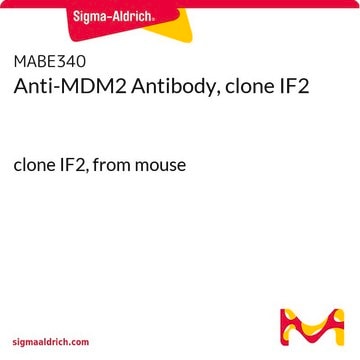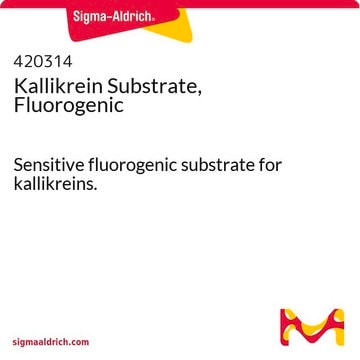OP46
Anti-MDM2 (Ab-1) Mouse mAb (IF2)
liquid, clone IF2, Calbiochem®
Synonym(s):
Anti-Murine Double Minute Chromosome-2, Anti-Ubiquitin Protein Ligase, Anti-p53 Binding Protein, Anti-Ubiquitin Protein Ligase, Anti-p53 Binding Protein, Anti-Murine Double Minute Chromosome-2
About This Item
Recommended Products
biological source
mouse
Quality Level
antibody form
purified antibody
antibody product type
primary antibodies
clone
IF2, monoclonal
form
liquid
contains
≤0.1% sodium azide as preservative (100 μg only)
species reactivity
human
should not react with
mouse
manufacturer/tradename
Calbiochem®
storage condition
do not freeze
isotype
IgG2b
shipped in
wet ice
storage temp.
2-8°C
target post-translational modification
unmodified
Gene Information
human ... MDM2(4193)
mouse ... Mdm2(17246)
General description
Immunogen
Application
Immunoblotting (0.5-2 µg/ml, chemiluminescence)
Immunofluorescence (1-5 µg/ml)
Immunoprecipitation (1 µg/sample)
Paraffin Sections (1-5 µg/ml, heat pre-treatment required, see application references)
Packaging
Warning
Physical form
Analysis Note
OSA-CL cells
Other Notes
Immunoblotting Protocol
MDM2 (Ab-1) can be used to detect MDM2 by Western blot of proteins previously separated by SDS/PAGE and electrophoretically transferred onto nitrocellulose membranes. The proteins are reacted with the monoclonal antibody and visualized using an HRP conjugated goat anti-mouse antibody with chemiluminescent detection.
Materials
Equipment:
• Electrophoresis apparatus
• Electroblotting apparatus
• Rocker platform
Solutions and Reagents
• Anti-MDM2 (Ab-1) Mouse mAb (IF2) Cat. No. OP46 or OP46T
• HRP conjugated goat anti-mouse IgG heavy and light chains (e.g. Cat. No. 401215)
• Chemiluminescence detection system
• ELB Buffer (include a cocktail of proetease inhibitors, such as 0.5 µg/ml leupeptin, 1 µg/ml pepstatin, 1 mM EDTA and 0.2 mM PMSF): 50 mM Hepes pH 7.0, 250 mM NaCl, 0.5 mM EDTA, 0.1% Nonidet P-40 Alternative
• SDS-PAGE (7% acrylamide)
• Phosphate buffered saline (PBS) pH 7.4; 1 Liter: 0.2 g KCl, 0.2 g KH2PO4, 8 g NaCl, 1.15 g Na2HPO4
• PBS/0.1% Tween®-20 detergent (PBST)
• 3% Non-fat Dry Milk in PBST
Procedure
1. Lyse cells in ELB Buffer. (Alternatively, cells can be lysed in RIPA Buffer or directly into 1x Laemmli Sample Buffer).
2. Electrophorese 50-100 µg lysate using a 7% acrylamide gel.
3. Transfer the protein samples from the polyacrylamide gel onto a nitrocellulose membrane using an electroblotting apparatus.
4. Block the membrane for 1 h in PBST containing 3% non-fat dry milk at room temperature with rocking. Use about 1 ml per cm2 of membrane.
5. Incubate the membrane with 1 µg/ml Anti-MDM2 (Ab-1) Mouse mAb (IF2) in 3% non-fat dry milk/ PBST for 1 h at room temperature with rocking.
6. Wash the membrane 3 times, 15 min each, in PBST at room temperature with rocking.
7. Incubate the membrane with HRP conjugated goat anti-mouse IgG heavy and light chain antibody, diluted according to the supplier’s instructions, in 3% non-fat dry milk/ PBST at room temperature for 1 h.
8. Wash the membrane 4 times, 15 min each, in PBST at room temperature with rocking.
9. Develop the membrane using chemiluminescent detection reagents according to manufacturer instructions.
10. Expose the membrane to film for ten minutes. Adjust subsequent exposure times as needed.
Marchetti, A., et al. 1995. J. Pathol.175, 31.
Barak, Y., et al. 1993. EMBO J.12, 461.
Ladanyi, M., et al. 1993. Cancer Res.53, 16.
Leach, F.S., et al. 1993. Cancer Res.53, 2231.
Oliner, J.D., et al. 1993. Nature362, 857.
Momand, J., et al. 1992. Cell69, 1237.
Oliner, J.D., et al. 1992. Nature358, 80.
Fakharzadeh, S.S., et al. 1991. EMBO J. 10, 1565.
Legal Information
Not finding the right product?
Try our Product Selector Tool.
Storage Class Code
10 - Combustible liquids
WGK
nwg
Flash Point(F)
Not applicable
Flash Point(C)
Not applicable
Certificates of Analysis (COA)
Search for Certificates of Analysis (COA) by entering the products Lot/Batch Number. Lot and Batch Numbers can be found on a product’s label following the words ‘Lot’ or ‘Batch’.
Already Own This Product?
Find documentation for the products that you have recently purchased in the Document Library.
Our team of scientists has experience in all areas of research including Life Science, Material Science, Chemical Synthesis, Chromatography, Analytical and many others.
Contact Technical Service






